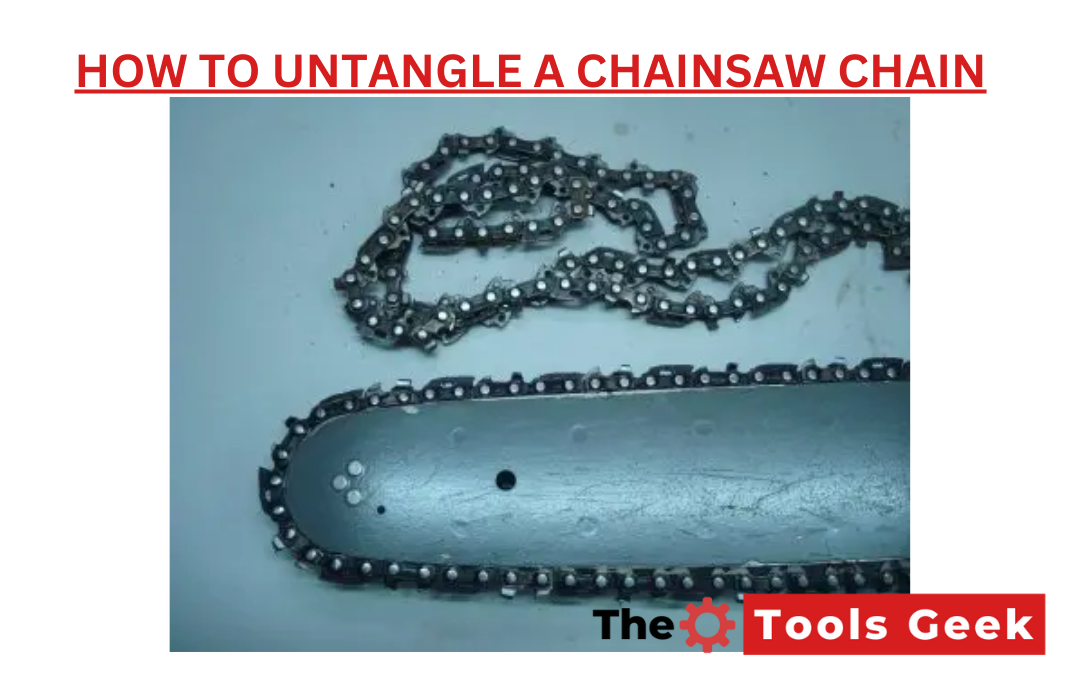Untangle or undo a chainsaw chain by removing the bar and carefully detangling the chain links. Chainsaw chains can get tangled due to improper storage or usage.
When this happens, it is important to address the problem before using the chainsaw again to prevent any accidents or further damage. Regular maintenance of the chainsaw can also prevent tangles from happening in the first place. In this article, we will explore the steps to untangle or undo a chainsaw chain and some tips on how to avoid tangles.
Whether you are a professional chainsaw operator or a diy enthusiast, this guide will help you keep your chainsaw in good working condition.
Understanding The Causes Of Chainsaw Chain Tangles
Identifying Common Circumstances That Lead To Tangles
Chainsaw chains are designed to spin consistently as the machine is used. However, chainsaw chain tangles occur sometimes due to certain circumstances. Identifying these circumstances beforehand can help prevent future tangles. Here are some common circumstances to watch out for:
- Uneven chain tension
- Incorrect chain installation
- Dull or damaged chain cutting edges
- Loose chain links or rivets
- Chain mismatches and sizes
Exploring How Chainsaw Chain Tangles Form
Chainsaw chain tangles usually form as a result of the chain being forced to bend in inappropriate ways during use. This bending interrupts the effective coordination needed between the chain and the machine, leading to tangles. Here are some ways chainsaw chain tangles can form:
- Twisting of the chain during use
- Forceful pushing or pulling on the chainsaw
- Incorrect use of a dull chain
- Cutting through wet wood
- Chain coming in contact with foreign objects during use
Learning How To Avoid Common Mistakes That Increase The Likelihood Of Tangles
Making certain mistakes during chainsaw use increases the likelihood of tangles. Avoiding these mistakes will keep your chainsaw running smoothly while reducing the possibility of chainsaw chain tangles. Here are some common mistakes to avoid:
- Rapid acceleration or abrupt stops of the chainsaw
- Overfeeding the chainsaw
- Allowing the chainsaw to come into contact with the ground or other foreign objects
- Not properly maintaining and lubricating the chainsaw and chain
- Using damaged or incorrect chains
Understanding the causes of chainsaw chain tangles is essential in managing your chainsaw and preventing future tangles. Keep these tips in mind to ensure efficient and effective chainsaw use.
Tools You Will Need To Untangle or Undo A Chainsaw Chain
Untangling a chainsaw chain can be a daunting task, but having the right tools handy can make the process a lot easier. In this section, we’ll explore the necessary tools for untangling a chainsaw chain, as well as important safety tools for chainsaw use and maintenance.
Necessary Tools For Untangling A Chainsaw Chain
When it comes to untangling a chainsaw chain, having the right tools on hand can make all the difference. Here are the essentials:
- A flat surface to work on
- Gloves for protection from sharp edges
- Pliers to grip the chain
- Screwdriver to loosen bolts on the chainsaw
- Wrench to remove nuts and bolts
- Bar groove cleaner to remove debris from chainsaw bar groove
- Chain lubricant to keep the chain running smoothly
Safety Tools For Chainsaw Use And Maintenance
Chainsaws are powerful tools that require proper safety precautions for use and maintenance. Here are some essential safety tools for chainsaw use and maintenance:
- Safety glasses to protect your eyes from debris
- Hearing protection to prevent hearing damage
- Gloves to protect your hands from sharp edges
- Chainsaw chaps to protect your legs from the chainsaw blade
- Face shield to protect your face from debris
- First aid kit to treat any injuries that may occur
Remember, safety should always come first when working with a chainsaw. Following proper safety protocols can help you avoid accidents and ensure that your chainsaw functions properly for years to come.
Untangling a chainsaw chain can be a tricky task, but with the right tools and safety measures in place, you can tackle it with confidence. Be sure to take your time and follow the proper steps to ensure an effective and safe outcome.
Step-By-Step Process Of Untangling A Chainsaw Chain
Assessing The Severity Of The Tangle
Before you attempt to untangle a chainsaw chain, it is essential to assess the severity of the tangle. Follow these key points to evaluate the situation:
- Turn off the chainsaw and ensure it is unplugged before proceeding.
- Look closely at the chain and determine how severe the tangles are.
- Check if the chain is twisted or knotted around itself.
- Identify if the chain has any broken links or cuts
- Make a note of any parts that seem worn out or damaged and need replacing.
Disassembling The Chainsaw
If the tangle is severe, disassembling the chainsaw is often the best solution. Please follow these steps carefully:
- Turn off the chainsaw and remove the spark plug wire.
- Remove the guide bar nuts and the guide bar plate.
- Lift out the chainsaw chain and ensure the tangle can be easily retrieved.
- Clean the chainsaw thoroughly, removing any dirt and debris.
Retrieving The Tangle From The Chainsaw
Once you have determined the tangle’s severity and disassembled the chainsaw, it is time to begin the untangling process. Follow these key points to ensure the task is completed smoothly:
- Use your fingers or needle-nose pliers to untangle the chain carefully.
- Check each link on the chain to make sure it is free from damage.
- If any links have damage, they should be marked to be replaced before reassembly.
- Clean the chain thoroughly to remove any debris.
Reassembling The Chainsaw
After you have untangled the chainsaw chain and assessed any damage, you should carefully reassemble the chainsaw. Follow these key points for guidance:
- First, ensure the chainsaw bar is in place and tightened securely.
- Align the chainsaw chain with the bar by routing it around the chainsaw sprocket.
- Using a guide bar plate, secure the chainsaw chain in place.
- Tighten the guide bar nuts to secure everything in place.
- Once everything is tightened, give the chainsaw chain a quick test to ensure everything is working correctly.
By following these simple steps, you should now be able to untangle your chainsaw chain without damaging it further. Remember to regularly clean and inspect your chainsaw to avoid further tangles and damage.
Tips For Maintaining Chainsaw Chains To Prevent Tangles
Chainsaws are indispensable tools for homeowners and professional loggers alike. However, technical issues such as tangled chains on chainsaws can slow down your work or even cause damage to your chainsaw. The good news is that most of the time, you can untangle the chainsaw’s chain on your own.
We’ll focus on tips for maintaining chainsaw chains to prevent tangles, covering topics such as routine chainsaw maintenance, proper chainsaw storage, and avoiding improper chainsaw use.
Routine Chainsaw Maintenance:
Maintaining your chainsaw is crucial to keep it in good working order. Regular maintenance means your chainsaw’s chains are less likely to get tangled, and it’ll last longer too. Follow these tips to maintain your chainsaw regularly:
- Check the chainsaw chain tension regularly. Loose chains can easily tangle and cause problems when cutting.
- Always keep the chain clean and lubricated. This helps the chainsaw to run smoothly and reduces the likelihood of chains getting stuck or tangled.
- Keep the chainsaw sharp by periodically sharpening the chainsaw’s teeth. A dull chainsaw can snag, causing the chainsaw to jam and the chain to tangle.
- Inspect the chainsaw for any damage before use. If you notice any problems, replace the damaged parts before use.
Proper Chainsaw Storage:
How you store your chainsaw affects its performance. When storing your chainsaw, consider the following:
- Always clean the chainsaw before storage. This removes sawdust and grime and reduces the likelihood of rust forming on the chain.
- Store the chainsaw in a dry, secure location to protect it from moisture or theft.
- Always keep the chainsaw chain lubricated and remove the fuel before storage. This prevents corrosion and gumming of the carburetor and makes strating it next time much easier.
Avoiding Improper Chainsaw Use:
Improper use of a chainsaw can cause chain tangling and other technical faults. Follow these guidelines when working with a chainsaw:
- Always use a chainsaw with a properly tensioned chain.
- Avoid running the chainsaw on the ground, as this can damage the chain and cause it to get tangled.
- Never force the chainsaw. Stalling, kicking back, or making unusual noises indicate that something is wrong, and you should stop using the chainsaw and investigate the issue before proceeding with cutting.
- Always wear personal protective equipment when using a chainsaw. It includes chain saw helmets, chainsaw pants, safety shoes or boots etc.
With these tips, you can prevent your chainsaw chain from getting tangled, making your work easier and safer. Regular checkups, storing the chainsaw properly, and following proper usage guidelines go a long way in keeping your chainsaw in top condition.
Frequently Asked Questions For How To Untangle or Undo A Chainsaw Chain
How Do You Untangle or Undo A Chainsaw Chain?
To untangle a chainsaw chain, you’ll need to remove the guide bar and saw chain from the chainsaw, locate the tangled area, and use a pair of pliers to untangle the chain. Then reassemble the saw chain and guide bar.
Why Does A Chainsaw Chain Get Tangled?
A chainsaw chain can get tangled due to various reasons, including incorrect installation, dull or damaged chain teeth, insufficient lubrication, or clogged guide bar groove. Avoiding these issues by proper maintenance can prevent tangles.
Can I Untangle or Undo A Chainsaw Chain With My Bare Hands?
Untangling a chainsaw chain with your bare hands is not advisable as it can be dangerous. Chainsaw chains are sharp and can easily cut through skin. Always use a pair of pliers or gloves to untangle the chain.
When Should I Replace My Chainsaw Chain?
You should replace your chainsaw chain when it’s dull or damaged beyond repair. Signs that it’s time to replace include difficulty cutting, increased vibration, and smoking. Inspect your chain regularly and replace it when needed.
How Often Should I Maintain My Chainsaw Chain?
It’s recommended to perform maintenance on your chainsaw chain after every use. This includes cleaning the chain and guide bar, checking for any damage or wear, and lubricating the chain. This will ensure its longevity and efficiency.
Conclusion
Now that you have gone through the process of untangling a chainsaw chain, it is important to remember to perform a regular tune-up. A little maintenance can go a long way in preventing issues with the chainsaw. Keeping the chain properly sharp, clean and lubricated is important.
Moreover, ensure to follow all the instructions carefully and make sure you have the right tools for the job. It could turn out to be an easy diy task with the right approach and knowledge. By properly managing your chainsaw, you can increase its longevity and avoid any potential hazards.
So, save money, time, and effort by learning how to untangle a chainsaw chain. With this simple guide, you can now get back to work on your yard or construction projects with a conveniently functioning chainsaw. Happy working!

